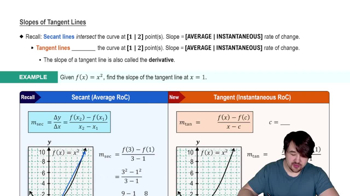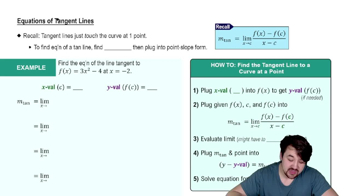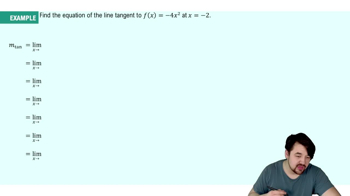Table of contents
- 0. Functions7h 52m
- Introduction to Functions16m
- Piecewise Functions10m
- Properties of Functions9m
- Common Functions1h 8m
- Transformations5m
- Combining Functions27m
- Exponent rules32m
- Exponential Functions28m
- Logarithmic Functions24m
- Properties of Logarithms34m
- Exponential & Logarithmic Equations35m
- Introduction to Trigonometric Functions38m
- Graphs of Trigonometric Functions44m
- Trigonometric Identities47m
- Inverse Trigonometric Functions48m
- 1. Limits and Continuity2h 2m
- 2. Intro to Derivatives1h 33m
- 3. Techniques of Differentiation3h 18m
- 4. Applications of Derivatives2h 38m
- 5. Graphical Applications of Derivatives6h 2m
- 6. Derivatives of Inverse, Exponential, & Logarithmic Functions2h 37m
- 7. Antiderivatives & Indefinite Integrals1h 26m
- 8. Definite Integrals4h 44m
- 9. Graphical Applications of Integrals2h 27m
- 10. Physics Applications of Integrals 2h 22m
2. Intro to Derivatives
Tangent Lines and Derivatives
Problem 38a
Textbook Question
Derivatives and tangent lines
a. For the following functions and values of a, find f′(a).
f(x) = 1/ x²; a= 1
 Verified step by step guidance
Verified step by step guidance1
Step 1: Identify the function f(x) = \frac{1}{x^2} and the point a = 1 where you need to find the derivative f'(a).
Step 2: Rewrite the function in a form that is easier to differentiate: f(x) = x^{-2}.
Step 3: Use the power rule for differentiation, which states that if f(x) = x^n, then f'(x) = nx^{n-1}. Apply this rule to f(x) = x^{-2}.
Step 4: Calculate the derivative: f'(x) = -2x^{-3}.
Step 5: Evaluate the derivative at the given point a = 1: f'(1) = -2(1)^{-3}.
 Verified video answer for a similar problem:
Verified video answer for a similar problem:This video solution was recommended by our tutors as helpful for the problem above
Video duration:
2mPlay a video:
Was this helpful?
Key Concepts
Here are the essential concepts you must grasp in order to answer the question correctly.
Derivatives
A derivative represents the rate of change of a function with respect to its variable. It is defined as the limit of the average rate of change of the function as the interval approaches zero. In practical terms, the derivative at a point gives the slope of the tangent line to the function at that point.
Recommended video:

Derivatives
Tangent Lines
A tangent line to a curve at a given point is a straight line that touches the curve at that point without crossing it. The slope of the tangent line is equal to the derivative of the function at that point. This concept is crucial for understanding how functions behave locally around specific values.
Recommended video:

Slopes of Tangent Lines
Limit Definition of Derivative
The limit definition of the derivative states that the derivative of a function f at a point a is given by the limit as h approaches zero of the difference quotient (f(a+h) - f(a))/h. This definition is foundational in calculus, as it formalizes the concept of instantaneous rate of change and is used to compute derivatives for various functions.
Recommended video:

Definition of the Definite Integral

 5:13m
5:13mWatch next
Master Slopes of Tangent Lines with a bite sized video explanation from Nick
Start learningRelated Videos
Related Practice



